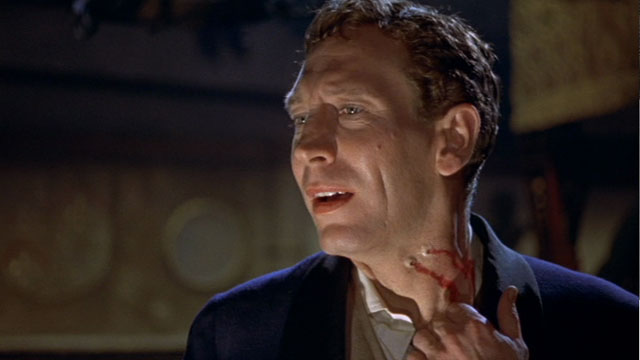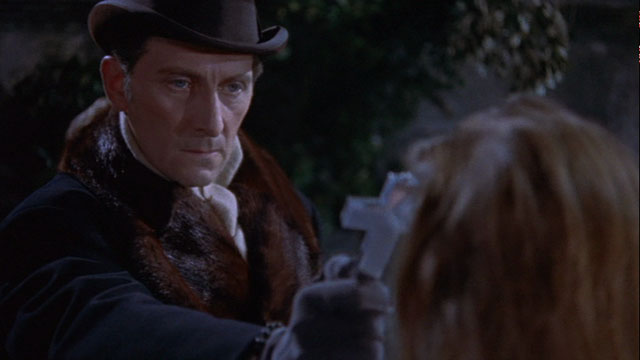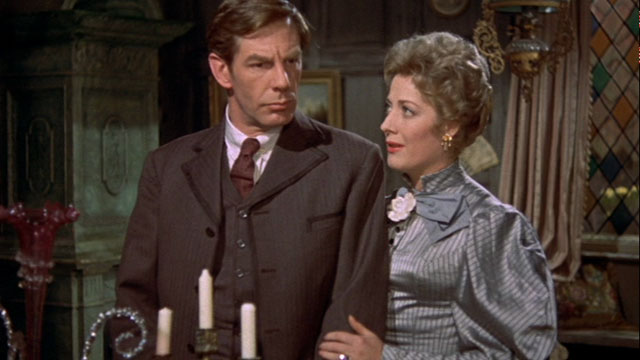“I’m afraid I don’t understand.” – Harker
This was excellent. I knew Hammer Horror was a major hole in my viewing history, but I’d had the wrong idea about it. Somehow assumed it was a studio of low-budget, slow, decorative films a la Blood For Dracula. Here’s Wikipedia on this film’s predecessor, 1957’s The Curse of Frankenstein: “Hammer’s first Gothic horror went into production. The use of colour encouraged a previously unseen level of gore. Until The Curse of Frankenstein horror films had not shown blood in a graphic way, or when they did it was concealed by monochrome photography. In this film, it was bright red, and the camera lingered upon it.” Of course, Hammer’s Dracula eventually went the way of all horror franchises, with increasingly silly sequels culminating in a showdown between Dracula and seven kung-fu brothers.
Jonathan Harker: John Van Eyssen, with a minor part in Quatermass 2 and no future in the cinema:

Harker roams around doing a lot of actory business for the first ten minutes, meets a girl who asks for help in vague terms, seems like the usual. But Harker isn’t the usual patsy – he’s actually here to kill Dracula. The girl, Drac’s wife, vamps out and Christopher Lee makes an awesome bloodshot-eyed bloody-mouthed action appearance, tossing her aside and biting Harker himself. JH goes into the basement the next day with stakes in hand, but stupidly kills the girl first, waking the main man who takes care of Harker easily.
Valerie Gaunt, also with no future in cinema, returning from Curse of Frankenstein:

Christopher Lee’s first Dracula movie and my first Hammer horror movie (not counting Moon Zero Two’s appearance on Mystery Science Theater). 36-year-old Lee went from minor roles in minor Powell/Pressburger flicks to the new face of British Horror in just two years.

Jonathan’s buddy Van Helsing figures things out and goes home to inform the family, but Harker’s girl Lucy dies of vampire-related causes. Lucy is the sister of either Mina or her husband Arthur, I dunno which, and V.H. soon becomes suspicious that Mina is under Dracula’s spell.
I don’t know Peter “Grand Moff Tarkin” Cushing very well. Looks like he didn’t recover from the collapse of his horror career in the late 70’s. He’s very good here, and carries the bulk of the movie.

I can’t remember who Mina was in the original novel but here, Lucy (Carol Marsh, star of a puppet version of Alice In Wonderland a decade prior) is Jonathan’s wife, and Mina (Melissa Stribling of The League of Gentlemen: the film thriller, not the TV comedy) is the wife of her brother Arthur (Michael Gough of The Small Back Room, later Alfred in the 90’s Batman films).

Mina gets the familiar marks on her neck and Van Helsing discovers Drac is hiding out in his own cellar. Some vampire hunter. Drac flees, tries to bury Mina (?) and gets killed by sunshine. Way more action-packed than the other Drac stories I’ve seen lately.
Hammer respected Dracula’s death less than Universal did – they had Lee play the Count a bunch more times beginning with Dracula: Prince of Darkness in ’66.
Wikipedia again: “The film was an enormous success, not only in Britain, but also in the USA, where it inspired numerous imitations from, amongst others, Roger Corman and American International Pictures. It also found success on the European continent, where Italian directors and audiences were particularly receptive.”


























